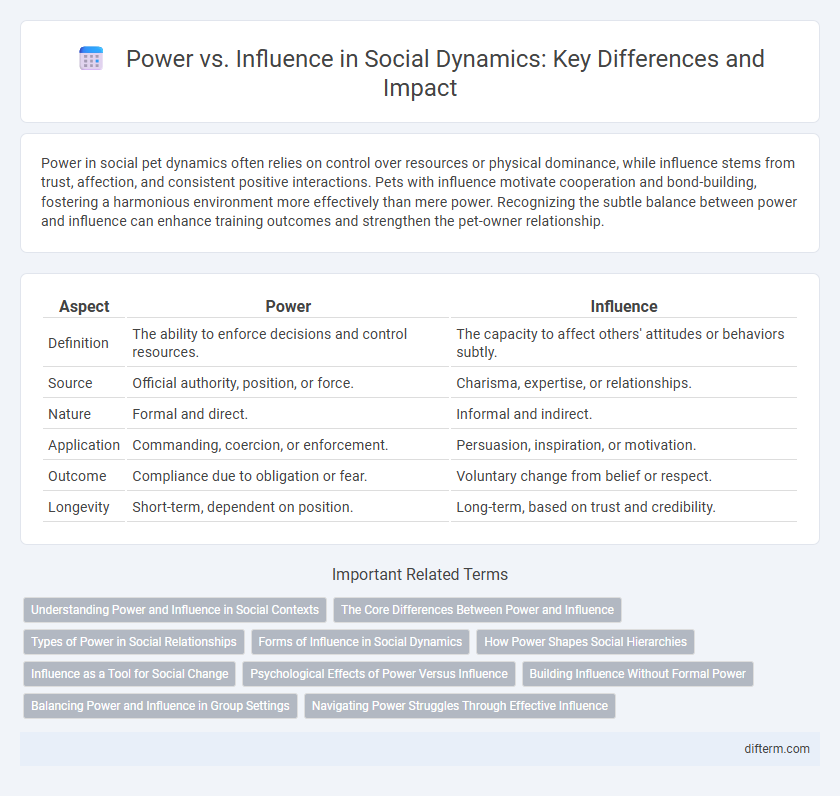Power in social pet dynamics often relies on control over resources or physical dominance, while influence stems from trust, affection, and consistent positive interactions. Pets with influence motivate cooperation and bond-building, fostering a harmonious environment more effectively than mere power. Recognizing the subtle balance between power and influence can enhance training outcomes and strengthen the pet-owner relationship.
Table of Comparison
| Aspect | Power | Influence |
|---|---|---|
| Definition | The ability to enforce decisions and control resources. | The capacity to affect others' attitudes or behaviors subtly. |
| Source | Official authority, position, or force. | Charisma, expertise, or relationships. |
| Nature | Formal and direct. | Informal and indirect. |
| Application | Commanding, coercion, or enforcement. | Persuasion, inspiration, or motivation. |
| Outcome | Compliance due to obligation or fear. | Voluntary change from belief or respect. |
| Longevity | Short-term, dependent on position. | Long-term, based on trust and credibility. |
Understanding Power and Influence in Social Contexts
Power in social contexts refers to the capacity to enforce decisions and control resources, whereas influence involves shaping others' attitudes or behaviors through persuasion and social dynamics. Understanding the distinction between power, often associated with authority and formal roles, and influence, linked to interpersonal skills and social networks, is crucial for effective leadership and conflict resolution. Analyzing how power structures and influence tactics operate within groups reveals their impact on social cohesion and group decision-making processes.
The Core Differences Between Power and Influence
Power is the ability to enforce decisions and control resources through authority or force, while influence shapes behaviors and attitudes by persuasion and relationships. Unlike power, which often relies on positional authority, influence emerges from trust, credibility, and emotional intelligence. Understanding that power compels compliance whereas influence inspires voluntary change is crucial in social dynamics and leadership effectiveness.
Types of Power in Social Relationships
Types of power in social relationships include coercive power, which relies on fear and punishment, and referent power, based on admiration and personal connection. Expert power stems from knowledge and skills, while legitimate power comes from formal roles or authority within a group. Understanding these distinct power sources helps explain dynamics in social interactions and group behavior.
Forms of Influence in Social Dynamics
Forms of influence in social dynamics include persuasive communication, social proof, and authority recognition, each shaping behavior and decision-making within groups. Persuasive communication leverages rhetoric and emotional appeal to alter attitudes, while social proof operates through conformity, prompting individuals to mimic majority actions. Authority recognition establishes influence by associating credibility and expertise with individuals or entities, guiding social norms and hierarchies.
How Power Shapes Social Hierarchies
Power directly determines the structure and dynamics of social hierarchies by controlling resources, access, and decision-making authority. Individuals or groups with concentrated power leverage it to establish dominance, marginalizing others and reinforcing their status within social networks. The distribution of power influences social mobility, with those in power shaping norms and values that perpetuate hierarchical stability.
Influence as a Tool for Social Change
Influence harnesses the power of persuasion and credibility to shape behaviors and opinions within communities, driving meaningful social change. Unlike power, which relies on authority and control, influence operates through trust, relationships, and effective communication. Social movements leverage influence to mobilize collective action and transform societal norms sustainably.
Psychological Effects of Power Versus Influence
Power often triggers psychological effects such as increased feelings of entitlement and reduced empathy, leading individuals to prioritize self-interest over group welfare. Influence, by contrast, fosters psychological states of empathy and cooperation, encouraging social bonding and mutual respect. These differing psychological impacts highlight why influence can create more sustainable and positive social dynamics than power alone.
Building Influence Without Formal Power
Building influence without formal power requires cultivating strong relationships, demonstrating expertise, and consistently adding value to others. Leveraging social capital through trust, empathy, and active listening enhances one's ability to persuade and motivate peers effectively. Influence grows from authentic connections and a reputation for reliability rather than from assigned authority or titles.
Balancing Power and Influence in Group Settings
Balancing power and influence in group settings requires a nuanced understanding of authority dynamics and interpersonal relationships. Effective leaders leverage influence to inspire collaboration, while judicious use of power ensures structure and accountability without fostering resentment. Optimizing this balance enhances group cohesion, decision-making, and overall social synergy.
Navigating Power Struggles Through Effective Influence
Power struggles often hinder social cohesion, but leveraging effective influence can transform conflicts into collaborative solutions. Strategic use of communication, empathy, and persuasion enhances one's influence, enabling the resolution of disputes without resorting to dominance or coercion. Mastering these skills fosters trust and cooperation, ultimately stabilizing relationships amidst power dynamics.
power vs influence Infographic

 difterm.com
difterm.com